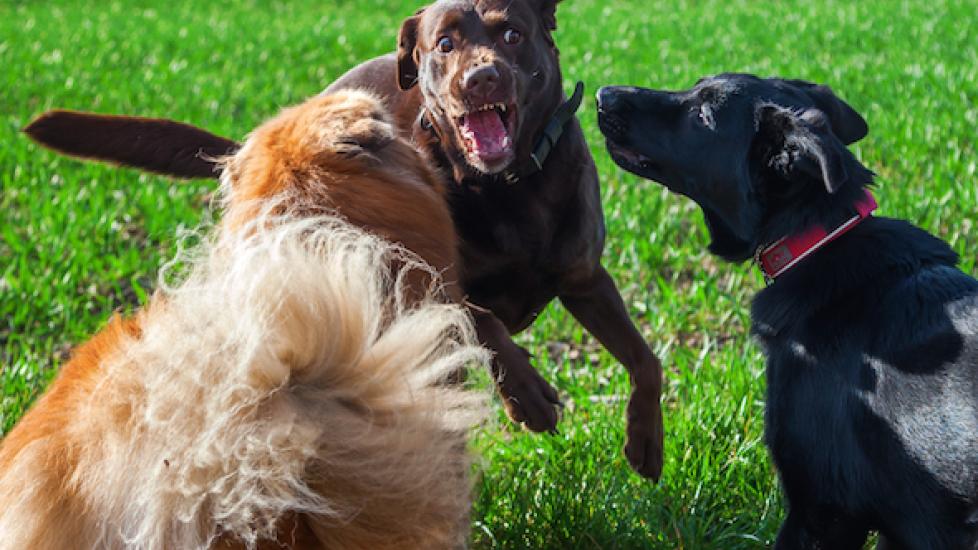What to Do During a Dog Fight
By Jennifer Coates, DVM
Most dogs want to socialize with members of their own species, otherwise they are living through a form of solitary confinement. Sure, dogs love human companionship, but every now and then they just want to hang out with someone who speaks their own (body) language.
But allowing dogs to get together isn’t without risk. Canine miscommunication, running into the “wrong” dog, and plain old bad luck may all lead to a dog fight. Knowing what to do before, during, and after dog fight is the best way to minimize injuries.
Prevention is the Best Defense
Of course preventing a dog fight is a far better option than dealing with it once it has begun. While you can’t control how other owners handle their dogs, you are in charge or your own dog’s training and management.
1. Keep an eye on the situation.
When your dog is interacting with or simply in the vicinity of other dogs, pay attention to the group dynamic. Now is not the time to get so engrossed in your phone, book, or conversation that you don’t notice when tensions are starting to rise. Normal, happy dog play often involves a lot of growling and wrestling so it can be difficult to determine when a problem is developing.
Signs to watch out for that indicate a dog fight could be imminent include:
- Raised hackles
- A stiff tail or body posture
- A deeper, more guttural tone to growling or barking
- Snarling that shows a lot of teeth
- Snapping
- A dog who is trying to get away but is not being allowed to do so
2. Practice basic obedience.
If you start to see signs of stress in your dog or other dogs in the group, call your dog to your side and reward him for coming. Tell him to sit and stay until he and the overall situation appear more relaxed. Work on obedience training on a regular basis, and always praise and reward good behavior. Your goal is to have complete confidence that no matter what is going on around him, your dog will immediately obey your command.
3. Know your dog’s weaknesses and triggers.
Some dogs are well behaved under most circumstances but have certain triggers that bring out the worst in them. For example, your dog might love to play with her housemate but can get aggressive when she feels her food is in danger of being taken away. The safest way to deal with situations like these is to avoid them. These two dogs should never be in the same area when food or treats are available.
Recommended Products
When a Dog Fight Happens Anyway
If despite your best efforts at prevention your dog does get into fight, keep in mind that your primary objective is to prevent significant injuries… to the dogs and to the people who are involved.
1. Don’t panic.
Many so-called dog fights are really just spats that consist of a lot of noise and posturing but which are over within seconds. If the dogs quickly separate on their own, approach your dog quietly and calmly, attach your leash, and leave the area.
2. Distract the dogs.
Is there a bowl or bucket of water or, better yet, a hose nearby? Thoroughly dousing the dogs, preferably in the face, will often get their minds off of fighting. Citronella or pepper spray can also be used. Some owners carry canisters with them for occasions just like this, but be aware that they can be quite irritating to innocent bystanders who are downwind. Loud noises will also sometimes work. Try honking a nearby car horn, blowing an air horn if one is available, banging on metal trash cans, etc.
3. Physically separate the dogs.
If the dogs can’t be distracted, try to find something you can put in between them. A board, large branch, cane, umbrella (quickly open it to startle the dogs), piece of plywood, chair, blanket, throw rug, welcome mat, thick winter coat… anything that is on hand and sturdy enough to prevent the dogs from biting one another (or you) could work. As a last resort, you can try grabbing your dog’s thighs, lifting him into a wheelbarrow position, and pulling him backwards, but this does involve some risk that you might be bitten. Never reach for your dog’s collar or head as this is the surest way to get injured during a dog fight.
After the Fight: Check Your Dog for Injuries
Once the fight is over you still need to be very careful around the dogs. They will be agitated and possibly scared and in pain, all of which increases the risk that they will bite. If your dog has obvious wounds, take him to the veterinarian immediately. Most bite wounds heal well when they are treated appropriately, but they almost invariably become infected when treatment is delayed. Even if your dog seems to be fine after the fight, keep a close eye on him. Some injuries may not become apparent for a few days.




